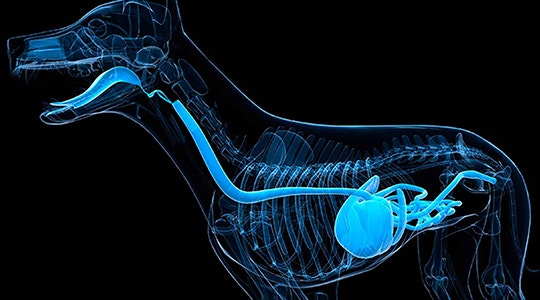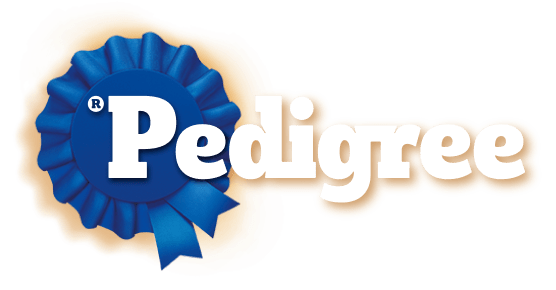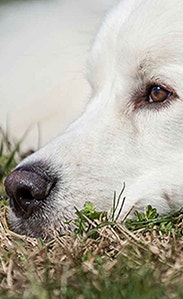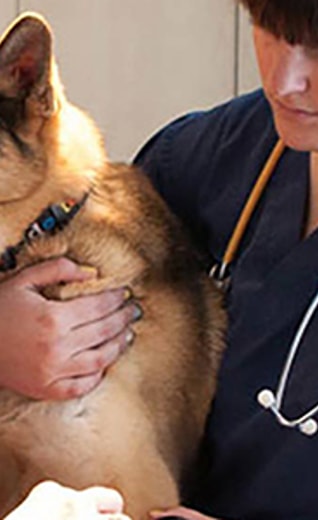
How Dogs Digest Food
Your role in the canine digestion process usually involves the 'before' and 'after.' Here's a look at what happens in the 'during' stage.
Nutrition 101
Dogs need to eat nutritious food in order to live a healthy life. The components of food that give them all the energy and raw materials they need are called 'nutrients.' After dogs eat, the nutrients in the food are digested, absorbed, and processed (or 'metabolized') by the body to fulfill the dog's needs.
The ins and outs of digestion
Food gets broken down into a simple form that can be absorbed and used by the body in a process called 'digestion.' In mammals, this process takes place in the digestive or alimentary tract, often simply called the 'gut.'This is a hollow tube that the food passes through and is acted upon by acids and enzymes from organs, like the stomach and small intestine that discharge into the tube. These digestive enzymes speed up the process of hydrolysis, by which food is broken down.
The three major classes of nutrients that need to be digested are carbohydrates, protein, and fat. Other nutrients (minerals, vitamins, and water) are absorbed in more or less the same form as they are found in food. But they may need to be released from proteins, fats, or carbohydrates before they can be absorbed.
Open wide and start digesting
Digestion begins in the mouth, where food is mechanically broken down and mixed with saliva before it's swallowed. Although dogs aren't strictly carnivores, their teeth are particularly suited to meat eating, and can cut, chew, and crush food. Still, many dogs have a tendency to bolt down their food, often chewing only the toughest of foods before swallowing.
The sight and smell of food stimulates the flow of saliva, causing the dribbling and 'lip smacking' often seen at mealtime. Once the food arrives in the mouth, its taste and physical presence help increase saliva production. Saliva contains mucus, a very effective lubricant that coats the food to help with swallowing.
The heart of the matter: the stomach
When food is swallowed, it passes down the esophagus, whose muscles contract with a 'wave' motion called peristalsis, and arrives at the stomach within a few seconds. The stomach has several functions. It's a storage organ; it's a mixing bag (where more digestive enzymes are added to the food); and it's a regulator valve that controls the rate of flow into the small intestine. Protein digestion begins in the stomach.
The stomach secretions contain protein-digesting enzymes (proteases), hydrochloric acid, and mucus. The major enzyme, pepsin, is secreted in an inactive form, pepsinogen, to stop it from digesting the cells that produce it. Pepsinogen is activated in the stomach in the presence of hydrochloric acid (the acid produced by the stomach to help digest food), which also creates the correct environment for the enzymes to function at their optimum rate. Mucus lubricates the food, and protects the lining of the stomach wall (which is largely protein) from being digested by its own enzymes. The secretion of acid, mucus, and enzymes depends on the composition and quantity of food eaten, and is regulated by hormones and nerves.
The wall of the stomach is muscular, particularly in the pyloric region, where the stomach connects to the intestines. The stomach contents are mixed thoroughly, and push towards the pyloric sphincter — a muscular ring that acts as a regulator valve. By this time, the mixture is a thick milky liquid called chyme, and several factors control its passage into the small intestine. Strong waves in the stomach cause the pyloric sphincter to relax, and allow food to pass into the duodenum (the first part of the small intestine). Chyme passes through more easily when it's very fluid.
On the other hand, the rate of emptying is reduced by the presence of chyme, acids, fats, or irritants in the duodenum, which inhibit movements in the stomach. This ensures that the stomach contents are well mixed and sufficiently well digested before they leave the stomach. It also ensures that the small intestine doesn't receive more chyme than it can cope with efficiently.
Small intestine: Big job
The duodenum is the main site for digestion in the small intestine. Here, more enzymes — from the intestinal wall and the pancreas — are added to the chyme. The pancreas is one of the major glands of the body, and has two functions: releasing digestive enzymes into the gut and releasing hormones into the blood.
Pancreatic juice also contains sodium bicarbonate, which neutralizes the acidic chyme arriving in the duodenum, and provides an alkaline environment for optimum functioning of pancreatic and intestinal enzymes. These enzymes include proteases (for continued protein digestion), amylase (for carbohydrate digestion), and lipase (for fat digestion).
The regulation of pancreatic juice release is largely controlled by two hormones — secretin and pancreozymin, more commonly known as cholecystokinin. These are secreted from cells in the wall of the small intestine. Another important function of the pancreas is to secrete the hormone insulin into the bloodstream to control blood sugar levels.
The role of other organs
The liver is the other major organ associated with the small intestine. Bile is produced continuously in the liver, stored in the gall bladder, and passed into the gut through the bile duct when it's needed. Bile contains salts that act like detergents by turning fat into tiny globules that can then be processed by the lipase enzymes in pancreatic juice. The pigments in bile give feces their characteristic color.
The digestion of food is completed in the small intestine, and once the food has been broken down to its simplest form, it can be absorbed across the wall of the intestine and into the blood. The end products of digestion are carried to the liver, where they are metabolized. Fat is absorbed into the lymph vessels, and is later transferred to the bloodstream.
The small intestines are very long, and absorption takes place along its entire length. Folds and finger-like projections, villi, in the lining of the intestinal wall dramatically increase the surface area for absorption. In some dogs, the absorptive area of the small intestine may be as large as the floor of a small room!
Nearing the end of the journey: The large intestine
By the time the food that's been eaten reaches the large intestine, most of the nutrients have been digested and absorbed. In this part of the gut, water is absorbed, and some fermentation of dietary fiber by bacteria takes place. This process is responsible for the production of gas, often associated with flatulence.
Feces are around 60–70% water, and the rest is made up of undigested food, dead bacteria, and some inorganic material. The feces are stored in the rectum and evacuated through the anal sphincter. And, if everything in the process has gone according to plan, this will happen outside your home when you take your dog for a walk.







